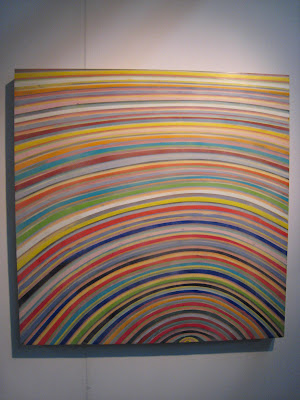
(staring into the belly of the beast-- Jenny Holzer addresses disinformation and the press, advertising and 24/7 media domination all amidst the rapid dissemination of our ever shrinking attention span like a wrecking ball in Protect Protect)
Protect Protect, currently on view at the Whitney is a tour de force of Jenny Holzer's painstakingly selected societal challenges from the past 30 years, spotlighting the artist's communication through the written word, which brings forth both a visceral and gut-wrenching reaction. Above is a selection of female human bones from her Lustmord series, which deal with the terrors of war brought on by the human catastrophe in the former Yugoslavia. Around each bone is clipped a metallic strip engraved in detail of how its victim was raped, tortured and murdered. To say this is a hard work to walk past is the understatement of the year, but in all honesty, this was truly one of the most difficult exhibitions of my entire life. I am a longtime Holzer supporter, and to me, she ultimately possesses a mastery over how words affect each of us, and how as a society we tend to never quite learn from history unless continuously confronted head-on.
Holzer's LED readouts are some of the most eye-poppingly gorgeous structures you will ever see. I loved reading the warning at the front of the Whitney for people who suffer from seizure disorders not to enter. No kidding. Seeing the show at night was jarring for a multitude of reasons, not the least of which was my own stepping into Holzer's past analogies via the visual eye candy of a Blade Runner future. For herein lies some truly astonishing works which will make your head spin if not from the neon colors, but from the rapid vertigo that will envelop you. In fact, some of the structures appear as if they were turbine-like engines more common in power or water plants. For here the LED readouts not only push our inner emotional buttons, but are the cogs feeding the machine that encompasses us all, much like fuel to the fire.
Holzer never lets us forget there's always more beneath the surface than what we are initially led to believe. From government-issued maps of the Iraqi invasion (with sections detailing to the soldiers the oil-rich areas), to her Redaction paintings which are copies of formerly classified documentation, we see how precarious the First Amendment came to being (and still is) a forgotten notion of a Utopian system of government. Can we simply block out the past, like the blackened fingerprints here show? The artist seems to ask, "If a tree falls in the woods and no one hears it, did it ever really fall?" Holzer is showing us the uncensored version, the big reveal being the many who have tried to rewrite history and thankfully failed. But even so, it is a battle still to be fought, and Holzer is not holding back, but waist-deep in the trenches.
Protect Protect runs through May 31st. Make sure to put it on your calendar. It's well worth your visit.




 (above, Michelle Manley,
(above, Michelle Manley, 


















 Last, but far from least,
Last, but far from least, 









 It's not often I get to see what's going on in Hungarian art today, but at Pulse I got a quick lesson in some quite nice color abstractions of
It's not often I get to see what's going on in Hungarian art today, but at Pulse I got a quick lesson in some quite nice color abstractions of 





 Next, something totally different. From before where I was celebrating color, now I've come to celebrate texture.
Next, something totally different. From before where I was celebrating color, now I've come to celebrate texture. 

 Recently I did a post where I mentioned how Allison
Recently I did a post where I mentioned how Allison 





 And finally, last, but not least,
And finally, last, but not least,